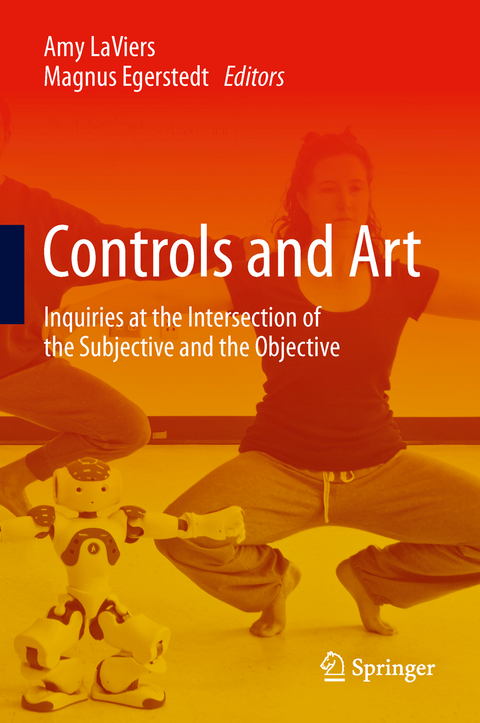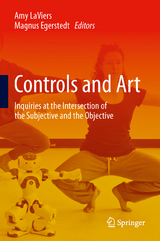Controls and Art
Springer International Publishing (Verlag)
978-3-319-03903-9 (ISBN)
Dancing humanoids, robotic art installations, and music generated by mathematically precise methods are no longer science fiction; in fact they are the subject of this book. This first-of-its-kind anthology assembles technical research that makes such creations possible. In order to mechanize something as enigmatic and personal as dance, researchers must delve deeply into two distinct academic disciplines: control theory and art. Broadly, this research uses techniques from the world of art to inspire methods in control, enables artistic endeavours using advanced control theory and aids in the analysis of art using metrics devised by a systems theoretic approach.
To ensure that artistic influences are well represented, the individual chapters are focused so that they relate their contribution to the arts meaningfully and explicitly. Specially composed introductions set up the contributions either in terms of inspiration by artistic principles or their contribution to the arts through new analysis tools. To facilitate this, the majority of the chapters are authored jointly by experts in control theory and by artists, including dancers, choreographers, puppeteers and painters. Connections between controls and art then permeate the text so that these important relationships play a central role in the book.
Controls and Art surveys current projects in this area-including a disco dancing robot, a reactive museum exhibit and otherworldly music-and illuminates open problems and topics for research in this emerging interdisciplinary field. It will draw attention both from experts in robotics and control interested in developing the artistic side of their creations and from academics studying dance, theater, music and the visual arts with an interest in avant-garde means of production.
Amy LaViers is an Assistant Professor at the University of Virginia and the director of the Robotics, Automation, and Dance (RAD) Lab. She completed an undergraduate thesis at Princeton University and a doctoral dissertation at Georgia Inst. of Technology that straddle the world of art and control engineering. Her thesis at Princeton received top thesis prizes and her dissertation at Georgia Tech was accompanied by a contemporary dance show entitled "Automaton." She is the co-organizer of two Invited Sessions (the first of their kind) on Controls and Art at the American Control Conference. She received the ECE Graduate Teaching Excellence Award at Georgia Tech and the Calvin Dodd MacCracken Senior Thesis Prize, Morgan Mckenzie Senior Thesis Prize, and Lyman Page Dance Award at Princeton. Magnus B. Egerstedt is a Professor in the School of Electrical and Computer Engineering at the Georgia Institute of Technology, where he has been on the faculty since 2001. He also holds an adjunct appointment in the School of Interactive Computing with the College of Computing at Georgia Tech. Magnus Egerstedt received the M.S. degree in Engineering Physics and the Ph.D. degree in Applied Mathematics from the Royal Institute of Technology, Stockholm, Sweden, in 1996 and 2000 respectively, and he received the B.A. degree in Philosophy from Stockholm University in 1996. Dr. Egerstedt's research interests include hybrid and networked control, with applications in motion planning, control and coordination of mobile robots, and he serves as Editor for Electronic Publications for the IEEE Control Systems Society and Associate Editor for the Journal of Discrete Event Systems and Nonlinear Analysis: Hybrid Systems. Magnus Egerstedt is the director of the Georgia Robotics and Intelligent Systems Laboratory (GRITS Lab), is a Fellow of the IEEE, received the ECE/GT Outstanding Junior Faculty Member Award in 2005, the Georgia Tech Teaching Efficiency Award in 2012, and the CAREER Award from the U.S. National Science Foundation in 2003. Other contributors – for Controls and Art, Amy LaViers and Magnus Egerstedt (Eds.): Frederico Augugliaro, ETH ZurichJohn Baillieul, Professor Boston UniversityRodrigo F. Cadiz, Pontificia Universidad Cato ́lica de ChileLuis Ignacio Reyes Castro, Massachusetts Institute of TechnologyWilla Chen, Princeton UniversityMarco Colasso, Pontificia Universidad Cato ́lica de ChileRaffaello D’Andrea, Professor, ETH ZurichKatherine Fitch, Princeton UniversityAndrew B. Godbehere, University of California – BerkeleyKen Goldberg, Professor, University of California – Berkeley Jason von Heinz Meyer, Center for Puppetry Arts, Atlanta, GAKelsey Hochgraf, Princeton UniversityCristian Huepe, CHuepe LabsElizabeth Jochum, Northwestern UniversityElliot Johnson, Northwestern UniversityPeter Kingston, Georgia Institute of TechnologyNaomi Leonard, Edwin Wiley Professor, Princeton University Susan Marshall, Director, Professor of Dance, Princeton UniversityTodd Murphey, Associate Professor, Northwestern UniversityKayhan Özcimder, Boston UniversityAngela Schoellig, Assistant Professor, University of TorontoJarvis Shultz, Northwestern UniversityHallie Siegel, ETH ZurichDaniel T. Swain, Princeton UniversityLori Teague, Director and Associate Professor, Emory UniversityAaron Trippe, Princeton UniversityPanagiotis Tsiotras, Professor, Georgia Institute of TechnologyGeorge F. Young, Princeton University
Metric Preference Learning with Applciations to Motion Imitation.- In the Dance Studio: An Art and Engineering Exploration of Human Flocking.- Dancing Robots: The Control Theory of Communication Through Movement.- So You Think You Can Dance?: Rhythmic Flight Performances with Quadrocopters.- Robotic Puppets and the Engineering of Autonomous Theatre.- The Artistic Geometry of Consensus Protocols.- Generating Music from Flocking Dynamics.- "Are We There Yet?": Visual Tracking of Visitors Under Variable Lighting.- Style-based Robotic Motion in Contemporart Dance Performance.
| Erscheint lt. Verlag | 4.2.2014 |
|---|---|
| Zusatzinfo | VIII, 235 p. 107 illus., 71 illus. in color. |
| Verlagsort | Cham |
| Sprache | englisch |
| Maße | 155 x 235 mm |
| Gewicht | 543 g |
| Themenwelt | Kunst / Musik / Theater |
| Sachbuch/Ratgeber ► Natur / Technik | |
| Informatik ► Theorie / Studium ► Künstliche Intelligenz / Robotik | |
| Technik ► Elektrotechnik / Energietechnik | |
| Schlagworte | Control Applications • Haptics in Dance • Human Flocking in Dance • Marionette Software • Mathematically-inspired Art • Robotic Dance • Systems Theory |
| ISBN-10 | 3-319-03903-2 / 3319039032 |
| ISBN-13 | 978-3-319-03903-9 / 9783319039039 |
| Zustand | Neuware |
| Haben Sie eine Frage zum Produkt? |
aus dem Bereich




